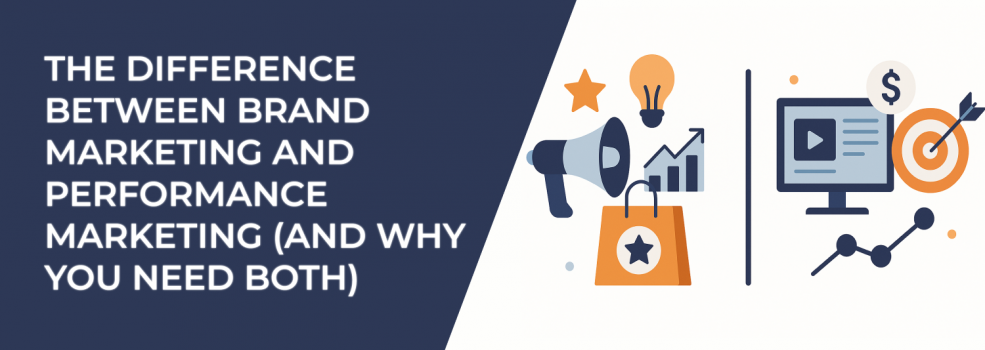Marketers often wonder whether to focus more on brand marketing or performance marketing. Both have their strengths, but they work best when used together. If you want long-term growth and consistent results, you need to understand how they differ and how they complement each other.
Let’s look at each one in detail.
What Is Brand Marketing?
Brand marketing is all about creating recognition and trust. Instead of pushing for quick sales, it builds the image and story of your company over time. This is what makes people remember you even when they aren’t ready to buy right away.
Think of it this way: when you see a logo or hear a slogan, and you immediately know which company it belongs to, that’s brand marketing at work. It’s about shaping how people feel about your business.
Brand marketing usually involves:
-
Awareness campaigns that get your name out there so people recognize it.
-
Storytelling that makes your business feel more human and relatable.
-
Consistency in how you present yourself so customers know what to expect.
-
Value-driven messages that show people what you stand for and why they should trust you.
Examples of brand marketing:
-
Coca-Cola’s long-running “Open Happiness” campaigns focus on emotion rather than product features.
-
Nike uses storytelling with athletes to inspire people to “Just Do It,” even if the ad isn’t directly about buying sneakers.
-
A small local business might run awareness ads on Facebook or Instagram showing behind-the-scenes videos to highlight company culture and values.
Each of these elements plays a role in building a lasting relationship with your audience. Without them, your business risks becoming just another forgettable option in a crowded market. If you’re not sure where to start, check out this step-by-step guide to defining your target audience — getting your audience right is the foundation of brand marketing.
What Is Performance Marketing?
Performance marketing takes a very different approach. Instead of focusing on long-term recognition, it’s all about getting measurable results right now. This could mean clicks, sign-ups, downloads, or purchases.
Because everything is tracked, advertisers can see exactly what they’re getting for their money. It’s great for businesses that want to move quickly and see short-term returns.
Some common parts of performance marketing include:
-
Clear goals and KPIs. Marketers track things like cost per lead or return on ad spend.
-
Testing and optimization. Ads, audiences, and bids are constantly adjusted to improve results.
-
Data-driven decisions. Campaigns rely on numbers rather than guesswork.
-
Focus on fast results. The aim is to drive immediate actions, not just attention.
Examples of performance marketing:
-
A Facebook retargeting campaign that reminds users of items left in their cart and pushes them to complete checkout.
-
Google search ads that appear when someone types “best CRM software” — designed to capture leads right when intent is highest.
-
An e-commerce brand running Instagram Story ads with a “Shop Now” button that directly tracks conversions.
-
A SaaS company using LinkedIn lead gen forms to collect sign-ups for a free demo.
This approach can be very efficient. But when it runs without brand support, results often stall. People may click, but if they don’t know or trust your brand, they may never complete the purchase. If you’ve ever struggled with ads not converting, you’ll want to read this guide on fixing underperforming Facebook campaigns.
The Difference Between Brand Marketing and Performance Marketing
The main difference is in the timeline. Brand marketing is slow and steady. It builds reputation over months and years. Performance marketing is fast and tactical. It drives actions today.
To put it simply:
-
Brand marketing shapes how people see you.
-
Performance marketing gets them to take action.
One works on emotions, the other on behavior. Together, they cover the full customer journey.
If you want to dig deeper into how campaign objectives impact results, check out this breakdown of Meta ad campaign objectives — it explains how to align your goals with the right type of performance campaign.
Why You Need Both
So, why can’t a business just choose one? Because customers don’t move in a straight line. They notice you, they think about you, and only later do they decide to buy.
If you rely only on performance marketing, you might see short bursts of results but struggle to build loyalty. On the other hand, if you only invest in brand marketing, you may build awareness but struggle to prove direct revenue.
When you put both strategies together, they support each other. Brand campaigns make people care about your business. Performance campaigns give them the final push to act. Over time, this balance leads to stronger results and lower costs.
Tips for Balancing Both Approaches
Finding the right balance can take some testing, but here are a few simple ways to start:
-
Divide your budget thoughtfully. A common split is around 60% for brand marketing and 40% for performance, but you should adjust based on your industry and goals. For example, a new company may need to lean more on brand building to get recognized, while an established company may focus more on conversions.
-
Keep your messaging consistent. If your brand ads tell one story and your performance ads tell another, people will feel confused. Make sure both approaches connect back to the same values and style.
-
Share insights across campaigns. Data from performance ads can show which messages people respond to most. Those insights can guide your brand campaigns. Likewise, brand research can help improve performance targeting. You can also learn how to reach the right audience with Facebook targeting basics — a skill that supports both brand and performance marketing.
-
Look at long-term returns. Brand building takes time, but it often lowers acquisition costs in the future. Don’t cut it off just because the results aren’t immediate.
By thinking about how both strategies work together, you can create marketing that is strong today and even stronger tomorrow.
Final Thoughts
Brand marketing and performance marketing are different, but they’re not opposites. One builds awareness and trust. The other drives quick actions. When you use both, you create a system where every campaign feeds into the next.
Customers notice you, remember you, and eventually choose you. Not just once — but again and again.
So instead of asking which one to use, the better question is: how can you combine them to grow faster and smarter?

